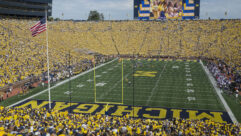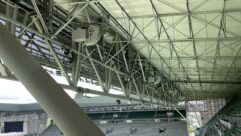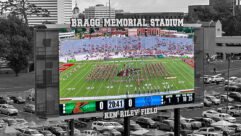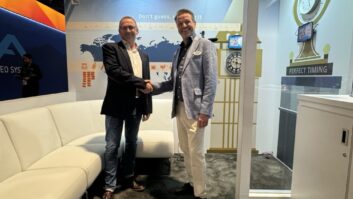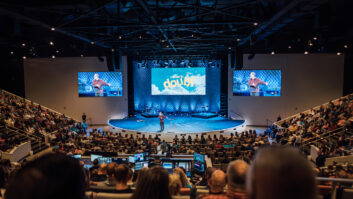
The Buzz: Installation Spotlight: Dolphin Stadium, Miami
May 1, 2007 12:00 PM,
By Charles Conte
Super Stadium AV

The concourse expansion project at Dolphin Stadium included the installation of nine new Yamaha DME64 digital mixing engines, replacing seven earlier DME32 versions.
Home to the NFL’s Miami Dolphins, baseball’s Florida Marlins, and Super Bowl XLI, Dolphin Stadium has undergone numerous changes since it opened in 1987.
In January 2005, stadium owner Wayne Huizenga announced a multi-year, three-phase expansion and renovation plan — remodeling the club level (nearly tripling the current area available for club spaces and suites); adding new scoreboards, restrooms, and concessions; and creating better traffic access to the stadium. The entire renovation for the 19-year-old venue, built for $115 million, is budgeted at $300 million.
By the Marlins’ home opener last baseball season, Daktronics ProStar LED HDTV-ready video systems were installed in both end zones, and by July, a Daktronics ProAd LED Fascia LED ribbon display. Huizenga also announced that the stadium would be renamed Dolphin Stadium last year. The name change was accompanied by a new logo that became part of a national branding campaign that peaked at Super Bowl XLI in February of this year.
The concourse expansion, which includes The Club Level, is a four-level structure developed to provide space to hold private events and entertainment. At press time, the concourse expansion was focused on the 100 Level and the 400 Level, which are both enclosed only by an open latticework framing. The ground level will feature plaza display areas. The 200 Level, enclosed by floor-to-ceiling windows, will feature entertainment venues and lounges with club seating and eight Panasonic TH-103PF9UK 103in. plasma displays installed behind the bar and in the lounge areas.
SYSTEMS RENOVATION
In the last year, the technical systems integration firm Pro Sound has implemented a series of four design-build systems renovation projects and one new construction project that took place throughout the baseball season, culminating this past December in time for the Super Bowl: 1) owner’s suite upgrade; 2) concourse expansion, phase 1; 3) control room renovation; 4) interior systems renovation; 5) digital link project. The common denominator among these projects — the self-contained owner’s suite upgrade excluded — is the use of Yamaha’s digital mixing engine, the DME64N. Seven DME64s were installed in March 2006, replacing seven DME32s from a Pro Sound 2002 upgrade project, and two more DME64s were added in the fall of that year.
“Everything being done in the stadium is based on the DME backbone via copper and CobraNet,” says Pro Sound VP and project head, Scott Pearson. (The CobraNet interface for digital communications is linked via fiber optics between the control room and the two amplifier rooms. This was the latest project, number five in the series.) The concourse expansion project built on an existing DME64 to add 16 Atlas AH66-12ST 12in. two-way stadium horns to cover the new 400 Level concourse areas and 130 8in. JBL Control 29AV loudspeakers in the ceiling of the remaining expansion areas. “For a horn-loaded system,” Pearson says, “we were pleasantly surprised by the low-frequency response of the Atlas speakers.” All loudspeakers are driven by QSC amplifiers running on the QSControl platform.
Projects three and four of the renovation took on the complete redesign and installation of the control room, and the total renovation of the stadium’s 70V systems, respectively. Previously, the control room was housed in a stadium suite with one rack in the center of the 18’×24′ room. After expanding the space, the control room has more of an edit-suite feel. Seven DME64Ns were added — one in the control room for routing, and six spread between two remote amp rooms for all audio within the bowl — and two Yamaha DM1000V2 digital audio consoles. “The operator’s console is a MIDI-remote master for the wired console located in the control room equipment racks,” Pearson says. “Both are seamlessly linked via MIDI and RS-485 to transmit control and meter data. We’re using both the card slots in the wired DM1000 for increased I/O capacity.
“We also added 10 Bittree patch bays to allow all the new control room equipment to be interfaced, and redesigned the Yamaha and QSControl user screens, expanding the QSControl to what we think is the largest CM16a [amplifier network monitor] system in the country. We can monitor up to 400 amp channels across 25 CM16a units on the customized QSCAD interface.”
The Interior Systems Renovation project involved adding two more Yamaha DME64Ns for all audio outside the bowl, and six Yamaha MY8-ADDA96 I/O cards for interior DSPs. Nine hundred Community Cloud ceiling speakers were added at this point as well.
The digital link project added more channel capacity going back and forth between amp rooms. “For example, during the Super Bowl,” Pearson says, “the NFL wanted to have two separate inputs into the system — all of the loudspeakers in the bowl and a second input that would just have the forward-firing, upper-deck speakers that they wanted to use as an auxiliary for the half-time system. But they wanted both systems to be active at the same time, with the upper-deck speakers minus EQ and time-delay so they could be time-aligned with their system. After we exhausted all the copper paths with this and other signal-routing requirements needed by the NFL, CobraNet was the only solution.”
SUBSCRIBE TO SOUND & VIDEO CONTRACTOR E-NEWSLETTERS!
- Sound & Video Contractor EXTRA
Systems Integration Special Focus series:
- Houses of Worship
- Corporate AV
- Residential AV
- AV Over Fiber
- AV in Education
Breaking industry news in your email inbox every other week!
Subscribe atwww.svconline.com


